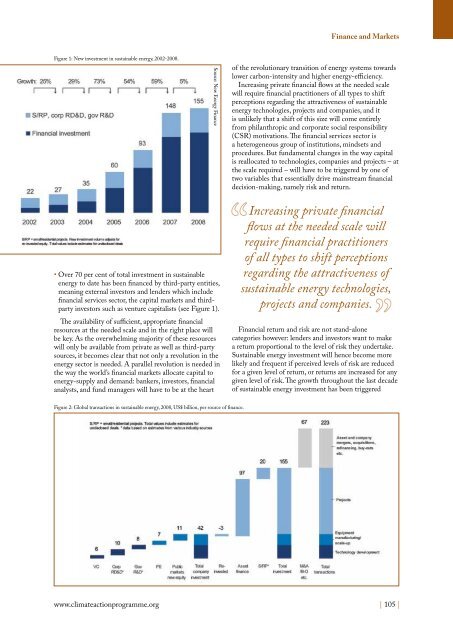Climate Action 2010-2011
Create successful ePaper yourself
Turn your PDF publications into a flip-book with our unique Google optimized e-Paper software.
Finance and Markets<br />
Figure 1: New investment in sustainable energy, 2002-2008.<br />
Source: New Energy Finance<br />
of the revolutionary transition of energy systems towards<br />
lower carbon-intensity and higher energy-efficiency.<br />
Increasing private financial flows at the needed scale<br />
will require financial practitioners of all types to shift<br />
perceptions regarding the attractiveness of sustainable<br />
energy technologies, projects and companies, and it<br />
is unlikely that a shift of this size will come entirely<br />
from philanthropic and corporate social responsibility<br />
(CSR) motivations. The financial services sector is<br />
a heterogeneous group of institutions, mindsets and<br />
procedures. But fundamental changes in the way capital<br />
is reallocated to technologies, companies and projects – at<br />
the scale required – will have to be triggered by one of<br />
two variables that essentially drive mainstream financial<br />
decision-making, namely risk and return.<br />
• Over 70 per cent of total investment in sustainable<br />
energy to date has been financed by third-party entities,<br />
meaning external investors and lenders which include<br />
financial services sector, the capital markets and thirdparty<br />
investors such as venture capitalists (see Figure 1).<br />
The availability of sufficient, appropriate financial<br />
resources at the needed scale and in the right place will<br />
be key. As the overwhelming majority of these resources<br />
will only be available from private as well as third-party<br />
sources, it becomes clear that not only a revolution in the<br />
energy sector is needed. A parallel revolution is needed in<br />
the way the world’s financial markets allocate capital to<br />
energy-supply and demand: bankers, investors, financial<br />
analysts, and fund managers will have to be at the heart<br />
Increasing private financial<br />
flows at the needed scale will<br />
require financial practitioners<br />
of all types to shift perceptions<br />
regarding the attractiveness of<br />
sustainable energy technologies,<br />
projects and companies.<br />
Financial return and risk are not stand-alone<br />
categories however: lenders and investors want to make<br />
a return proportional to the level of risk they undertake.<br />
Sustainable energy investment will hence become more<br />
likely and frequent if perceived levels of risk are reduced<br />
for a given level of return, or returns are increased for any<br />
given level of risk. The growth throughout the last decade<br />
of sustainable energy investment has been triggered<br />
Figure 2: Global transactions in sustainable energy, 2008, US$ billion, per source of finance.<br />
www.climateactionprogramme.org | 105 |












